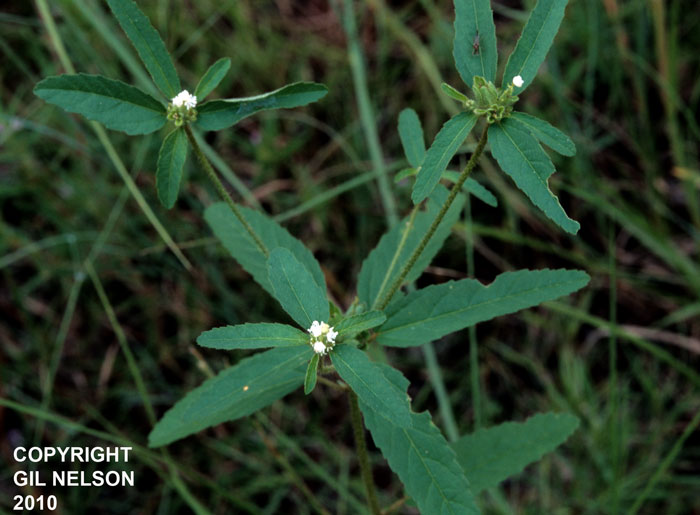Croton glandulosus
| Croton glandulosus | |
|---|---|

| |
| photo by Gil Nelson | |
| Scientific classification | |
| Kingdom: | Plantae |
| Division: | Magnoliophyta - Flowering plants |
| Class: | Magnoliopsida – Dicotyledons |
| Order: | Euphorbiales |
| Family: | Euphorbiaceae |
| Genus: | Croton |
| Species: | C. glandulosus |
| Binomial name | |
| Croton glandulosus L. | |

| |
| Natural range of Croton glandulosus from USDA NRCS Plants Database. | |
Common name: vente conmigo
Contents
Taxonomic notes
Description
Distribution
Ecology
Habitat
It can be found in mid-grass prairie communities.[1] It can also be found in longleaf pine communities, though it is not as common since they're dominated by perennial species.[2] This species has been observed in sandy and sandy loam soils of turkey oak ridges, open fields and clearings, wet borders of swamps, cabbage palm hammocks, dunes, and the ecotone between trees and shoreline of beaches. This species also occurs in human disturbed areas such as grassy highway medians, grassy edges of parking lots, along railroad tracks, waste areas, sandy roadsides, corn fields, and citrus groves[3].
Associated species includes Quercus laevis, Q. geminata, Baptisia, Selaginella, Polygonella, Commelina, Pinus palustris, Haplopappus divaricatus, Pityopsis, Palofoxia, Ambrosia, and Conyza[3].
Phenology
It is seasonal; it is mainly found from May to December, peaking in September in a study at Padre Island.[1] It has been observed flowering and fruiting June through October and fruiting in December[3].
Seed dispersal
According to Kay Kirkman, a plant ecologist, this species disperses by explosion mechanisms or by ants. [4]
Seed bank and germination
It germinates after fire.[1]
Fire ecology
It is included in the flowering plant survery – post burn – in Heuberger’s study[5]
Pollination
The following Hymenoptera families and species were observed visiting flowers of Croton glandulosus at Archbold Biological Station: [6]
Sphecidae: Cerceris blakei, Philanthus ventilabris
Conservation and management
Cultivation and restoration
Photo Gallery
References and notes
- ↑ 1.0 1.1 1.2 Lonard, R. I., F. W. Judd, et al. (2004). "Recovery of vegetation following a wildfire in a barrier island grassland, Padre Island National Seashore, Texas." Southwestern Naturalist 49: 173-188.
- ↑ Simkin, S. M., W. K. Michener, et al. (2001). "Plant response following soil disturbance in a longleaf pine ecosystem." Journal of the Torrey Botanical Society 128: 208-218.
- ↑ 3.0 3.1 3.2 Florida State University Robert K. Godfrey Herbarium database. URL: http://herbarium.bio.fsu.edu. Last accessed: June 2014. Collectors: Loran C. Anderson, G. Avery, D. Burch, Andre F. Clewell, Delzie Demaree, R. F. Doren,S. F. da Fonseca, B. J. Frier, Robert K. Godfrey, H. S. Irwin, D. Jones, Walter S. Judd, Beverly Judd, Gary R. Knight, R. Komarek, Robert Kral, Mabel Kral, Merle Kuns, O. Lakela, Robert L. Lazor, Karen MacClendon, F. Matthews, Sidney McDaniel, Richard S. Mitchell, Leon Neal, J. B. Nelson, R. A. Norris, Gwynn W. Ramsey, R. Reis dos Santos, Cecil R. Slaughter, R. Souza, V. I. Sullivan, Amanda R. Travis, Edwin L. Tyson, and D. B. Ward. States and Counties: Florida: Bay, Calhoun, Citrus, Collier, Dade, Franklin, Hernando, Highlands, Jackson, Jefferson, Lafayette, Lake, Leon, Levy, Liberty, Madison, Martin, Nassau, Okaloosa, Pinellas, Polk, Putnam, Seminole, St. Johns, Taylor, Volusia, and Wakulla. Georgia: Thomas. Other Countries: Honduras, Bolivia, and Brazil.
- ↑ Kay Kirkman, unpublished data, 2015.
- ↑ Heuberger, K. A. and F. E. Putz (2003). "Fire in the suburbs: ecological impacts of prescribed fire in small remnants of longleaf pine (Pinus palustris) sandhill." Restoration Ecology 11: 72-81.
- ↑ Deyrup, M.A. and N.D. 2015. Database of observations of Hymenoptera visitations to flowers of plants on Archbold Biological Station, Florida, USA.